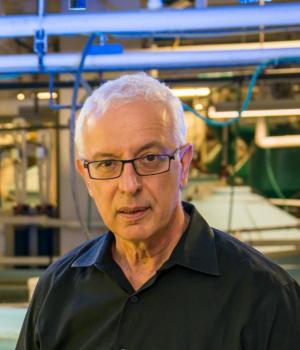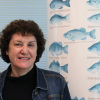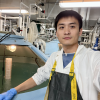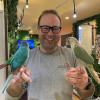
Yonathan Zohar
Research Interests
- Basic and applied aspects of fish reproductive physiology and molecular endocrinology
- Broodstock management and hatchery technologies
- Aquaculture and fisheries biotechnology
- Environmentally sustainable recirculating marine aquaculture
The primary focus of my research program is on basic and applied aspects of fish reproductive physiology and endocrinology. A major obstacle for the development and intensification of the finfish aquaculture industry is the failure of farmed fish to reproduce predictably when raised in captivity. We therefore use physiological, endocrine and molecular approaches to study interactions along the brain-pituitary-gonadal axis leading to reproductive development, gamete maturation, ovulation and spawning. Our research species include commercially important farmed fish, such as salmon, seabass, striped bass, seabream, bluefin tuna, and the zebrafish model. From our basic research, we develop technologies for the exogenous manipulation of fish reproduction, to be used in the aquaculture industry for year-round production of fertilized eggs and viable juveniles. These and other areas of interest are described below.
Endocrine control of reproduction along the brain-pituitary-gonad axis
In fish, the processes of reproductive maturation, gamete production, ovulation and spawning are controlled by hormonal factors common to all vertebrates. In response to environmental cues, the neuropeptide gonadotropin-releasing hormone (GnRH) is produced in the brain. The major function of GnRH is to induce the synthesis and release of the gonadotropin hormones (GtHs) from the pituitary, which in turn regulate gonadal development. Work in my laboratory has shown that the failure of farmed fish to reproduce reliably in captivity is caused by a dysfunction in the GnRH system, thus lack of GtH release and failure to spawn. We have also shown that many fish species produce three distinct forms of GnRH in the brain, suggesting multiple functions for this hormone. We therefore place special emphasis on the GnRH-GtH axis in studying the endocrine control of fish reproduction.
The ultimate aim of our studies is to better understand the underlying causes of reproductive dysfunction in farmed fish. From a comparative point of view, our research also seeks to contribute to the understanding of vertebrate reproduction in general.
Applied reproductive technologies for aquaculture and fisheries
A major focus of the work in my laboratory is the application of knowledge gained from our basic studies to the improvement of the aquaculture industry. An early success in this area has been the development of controlled-release, polymeric delivery systems for the administration of GnRHs and GnRH analogs to fish. Using these delivery systems to sustain GnRH levels in the blood can overcome the hormonal failure responsible for the lack of spontaneous ovulation and spawning common in many cultured species. This technology is also used to advance or synchronize natural spawning in order to increase seed production, induce spawning out of season, generate hybrid offspring, or enhance restocking programs, and has been applied in a wide range of species.
Another practical application of manipulating the reproductive axis is the generation of reproductively sterile fish. Producing sterile populations is an important goal in aquaculture for many reasons - sterile fish grow faster, selectively bred or otherwise proprietary broodstock can be protected, and the environmental impact of 'escapees' in cage-culture settings is greatly reduced using sterile fish. Our approach is to disrupt the very early development of the gonads (ovaries and testes), which leads to fish deprived of gametes (eggs, sperm) and thus reproductive sterility. After proving this concept in the zebrafish model, we have been collaborating with colleagues from academia and industry to optimize and implement our technology in commercially important farmed fish such as Atlantic salmon, trout, black cod, tilapia and other species.
Recirculating marine aquaculture
The continuous decline of the world's commercially harvested species has led scientists to conclude that the oceans have attained their maximum sustainable yield, and that global marine fisheries are in danger of collapse. The necessity to farm rather than harvest food fish has become increasingly clear. Yet, in spite of the significant growth of the aquaculture industry, marine species only account for about one third of total aquaculture production. A major obstacle to the growth of marine aquaculture has been the interaction between current production practices, mainly floating net-pens (cages), and the marine and coastal environments. While coastal cages may generate adverse chemical and biological effects on the environment, in many cases the environment is also not conducive to the optimal growth and health of the species of interest. In response to this situation, researchers at IMET have collaborated in the development of land-based, fully contained, recirculating marine aquaculture systems (RAS) that are able to grow high densities of commercially important fish using artificial seawater. A unique microbial bio-filtration in these systems is able to support high-density, "bio-secure" aquaculture with virtually no water exchange, thereby eliminating harmful effluents or escapees and ensuring no interaction with the environment. Dissolved waste is biologically converted to non-toxic elements and solid/organic waste is efficiently converted to fuel-grade biogas (methane) that is used to offset the energy demands of the operation. Marine RAS operations provide optimal conditions for best fish performance and can be located in non-traditional settings, such as urban or rural inland environments. These systems offer a new generation of aquaculture technologies that can be used to economically produce a wide range of marine food fish in a way that is ecologically responsible and environmentally sustainable. We have collaborated with several research laboratories, as well as with many aquaculture companies nationally and internationally, to support and build capacity for this emerging sector of the aquaculture industry.
Recirculating Aquaculture Salmon Network (RAS-N)
Fueled by the ever-increasing imports of Atlantic salmon to the US, and the challenges of expanding domestic net-pen production of this species, we are now witnessing major investments in US land-based production of Atlantic salmon. To help build capacity for this rapidly expanding industry, NOAA/Sea Grant have funded a national public-private consortium (which I lead) aimed at “building capacity for land-based Atlantic salmon aquaculture in the US”. This consortium, the Recirculating Aquaculture Salmon Network (RAS-N), consists of academia, industry and federal labs in five states across the US. RAS-N’s mission is to facilitate the growth of environmentally sustainable and economically feasible Atlantic salmon RAS production in this country, in order to provide better food security and reduce the current trade deficit associated with salmon imports. RAS-N works closely with US stakeholders in order to establish a holistic hub of knowledge that integrates past, current and future research, as well as economic analysis, extension, outreach & education and workforce training, to promote the successful growth and stability of the Atlantic salmon RAS sector and, more broadly, US aquaculture. The main outcomes of this collaborative program will be the integration, synergism and amplification of the expertise and skills of the RAS-N consortium partners for the benefit of the industry, and the development of a consensus road map/strategic plan and demonstration projects that will help policymakers, federal agencies and industry identify and responsibly allocate resources to promote an economically and environmentally sustainable land-based US Atlantic salmon industry.
Features on RAS-N:







